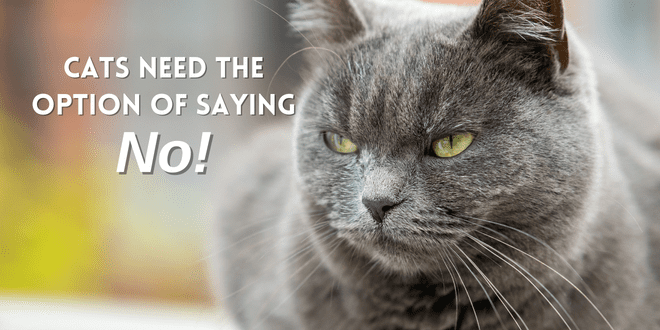
I’m obviously not referring to how a human being would say no, but rather, how your cat says it through body language and physical positioning. It’s important for your cat to be able to have the choice to say yes or no in many aspects of his life. It’s about consent, choice and control. If you want to build trust and have a good relationship, your cat should have the ability to offer consent and be given choice whether to interact or avoid. It only takes seconds to “ask” your cat for consent rather than startle or make him feel he doesn’t have control in his environment.
Even when a cat gives consent, pay attention to the type of interaction and duration. For example, if you want to pet the cat, pay attention to where on the body is ok and where is off-limits, and for how long to pet. Just because a cat likes you to pet him on the head doesn’t mean it’s ok to pet along the spine and it’s not a blanket approval to pet for as long as you want.
Cats Don’t Like Feeling Cornered
We love our cats and enjoy all forms of interaction with them whether that’s petting, holding, playing, training, etc. There are times though when they may not be in the mood and unless it’s something that has to be done, such as getting the cat in the carrier for a veterinarian visit, keeping a cat out of danger, or administering medication, the quickest way to cause the deterioration of the relationship is if you force the issue. Your cat should have the option to consent when it comes to interaction or let you know he’d rather have his space. Even with the above examples of administering meds and veterinary visits, there are better ways than forcing your cat. Use force free methods through positive, gentle training, to help your cat become comfortable with those experiences that are typically viewed as negative.
Ask for Consent
Having choice is a huge factor in reducing stress and increasing trust. Use positive, humane behavior techniques to show your cat that saying yes is more worthwhile but that the option is totally his. Pay attention to whether your cat is consenting. For example, if you’d like to pet a cat who may be unsure whether he wants interaction, extend your finger and use proper feline etiquette so he has the choice of whether to approach and engage. He may sniff your finger (the same nose-to-nose sniffing that cats do with each other upon greeting) and rub against it or even move closer to you, which is a signal that he’s ok with more interaction. He may also choose to back away or simply not engage at all. Don’t insist on interaction if the cat backs away.
Other signs indicating he isn’t giving consent may include:
- Lip licking (when there’s no food present)
- Self grooming
- Yawning
- Looking away from you
- Shifting position to a less relaxed pose
- Vocalizing
- Increasing the distance from you
If you ignore feline etiquette and just reach out to pet him then you don’t give him any choice — he hasn’t given consent. The next time you approach he may immediately react negatively since previous experience taught him that he won’t be given time to decide whether to interact. If you do the finger extension and wait for his response then the chances are he’ll be even more receptive the next time because you haven’t forced the issue. Provide choice and wait for consent. These are simple things to do but they can be so powerfully effective in building trust and creating a bond.
Pay Attention to How Your Cat Communicates
Pay closer attention to your cat’s body language because in many cases it’s providing the go-ahead to decrease the distance between the two of you or it’s saying to increase the distance. The longer you live with your cat, the more you’ll become familiar with his typical ways of communicating that he’d rather nap undisturbed, or that he does or doesn’t want to be petted right now. If you respect when your cat is saying no, you’ll discover he’ll end up saying yes more often.
Pay attention to your cat’s body language. If you’re petting him and he starts displaying signals that suggest he has had enough, then back off. The cat is saying no and if you ignore that message then it causes him to feel trapped in a corner with no other option but to either 1) scratch you, 2) bite you, 3) or go away from you. Even though option #3 is better than the other two, it’s still not what you want in your relationship with your cat.
Watch for body language signals that indicate your cat is no longer enjoying the interaction. They may include:
- Body stiffening
- vocalizing
- Cessation of purring
- Sideways or flattened ear position
- Skin twitching
- Claws extended
- Body position shifting
- Lifting front paw to prepare to swat
- Flicking or lashing tail
- Dilated pupils
- Increasing the distance
Build a Relationship of Trust
Think about it — do you respond well when you aren’t given a choice? Isn’t it nice to be asked for your consent? Animals deserve that as well.
Need More Information?
For more information on cat behavior and training, refer to the books by Pam Johnson-Bennett. Pam’s books are available at bookstores and online. We’ve included links to Amazon here on our website.
If you have a question regarding your cat’s health, please contact your veterinarian. This article is not intended as a replacement for your cat’s veterinary care.


